Long Duration Energy Storage for the Power System
Long Duration Energy Storage
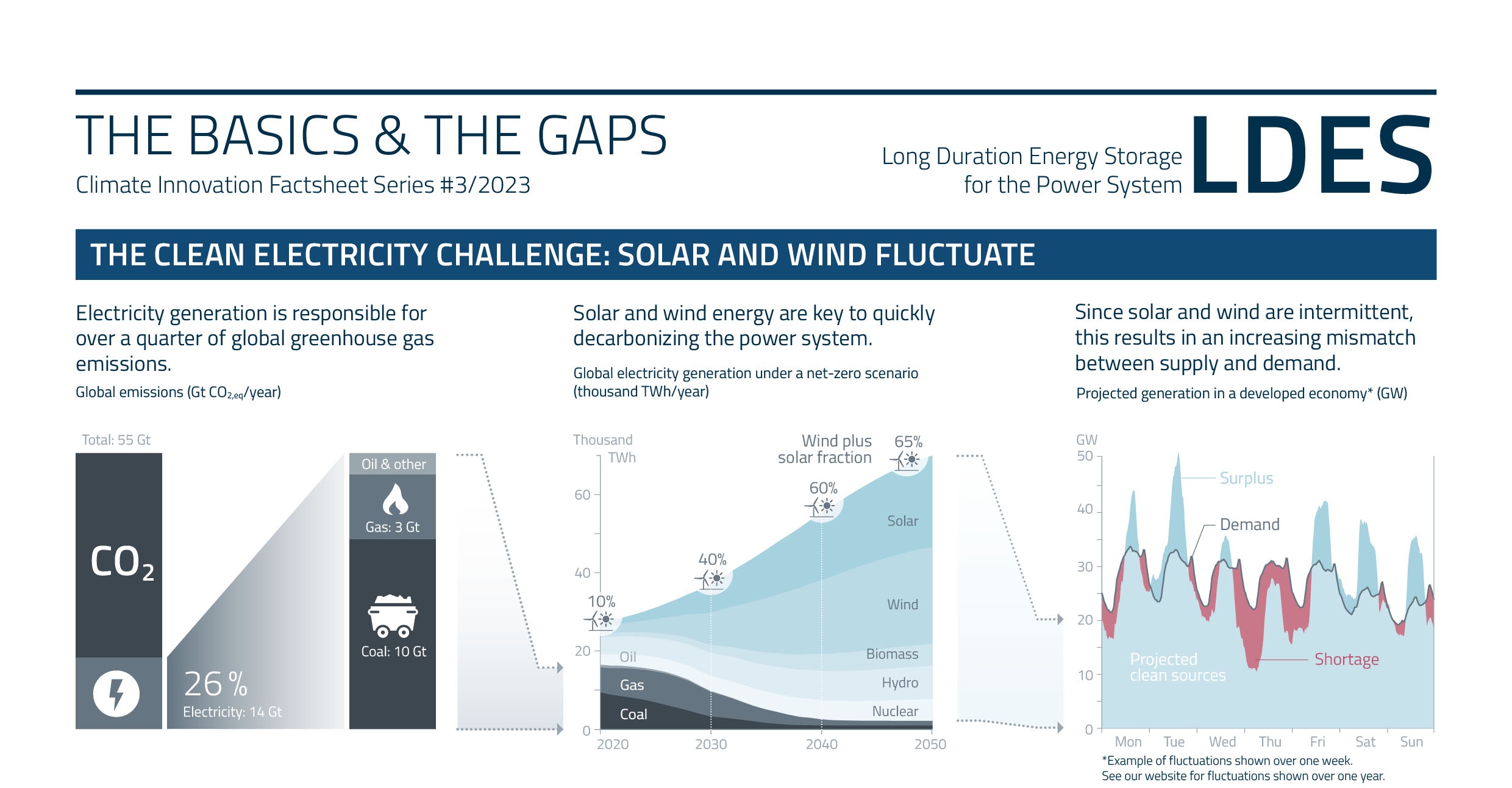

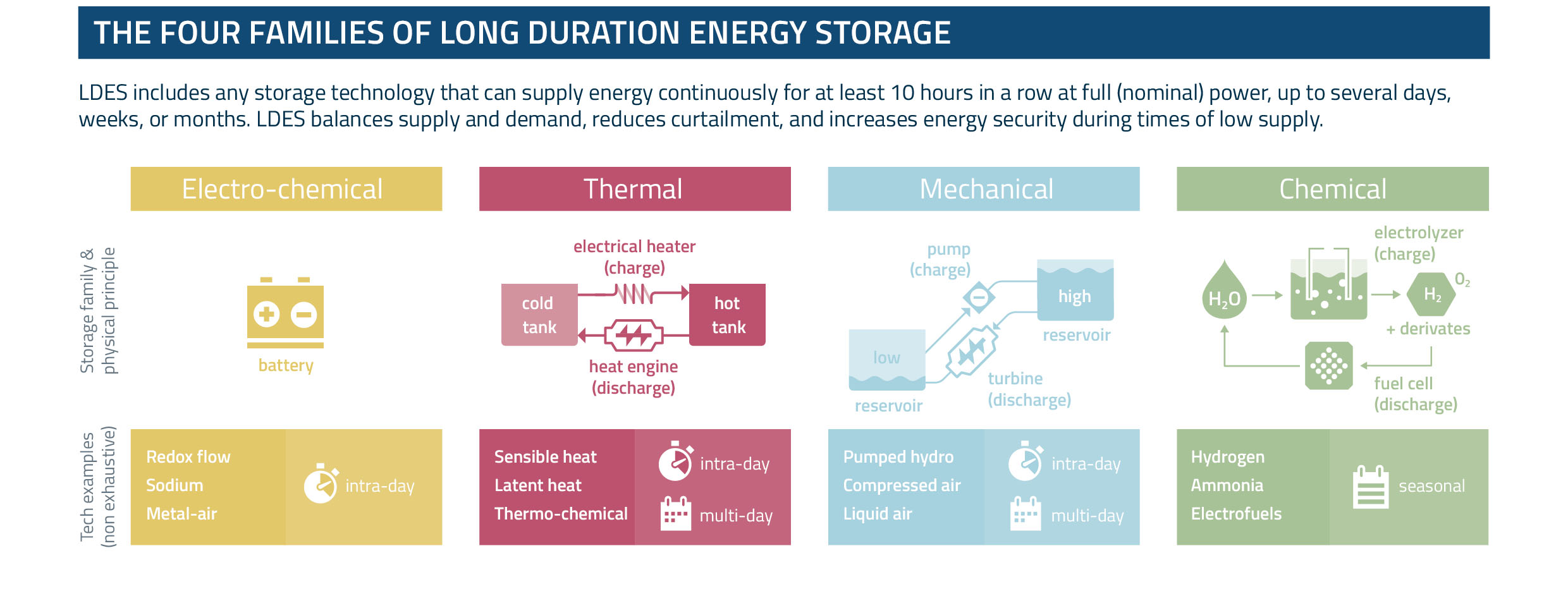
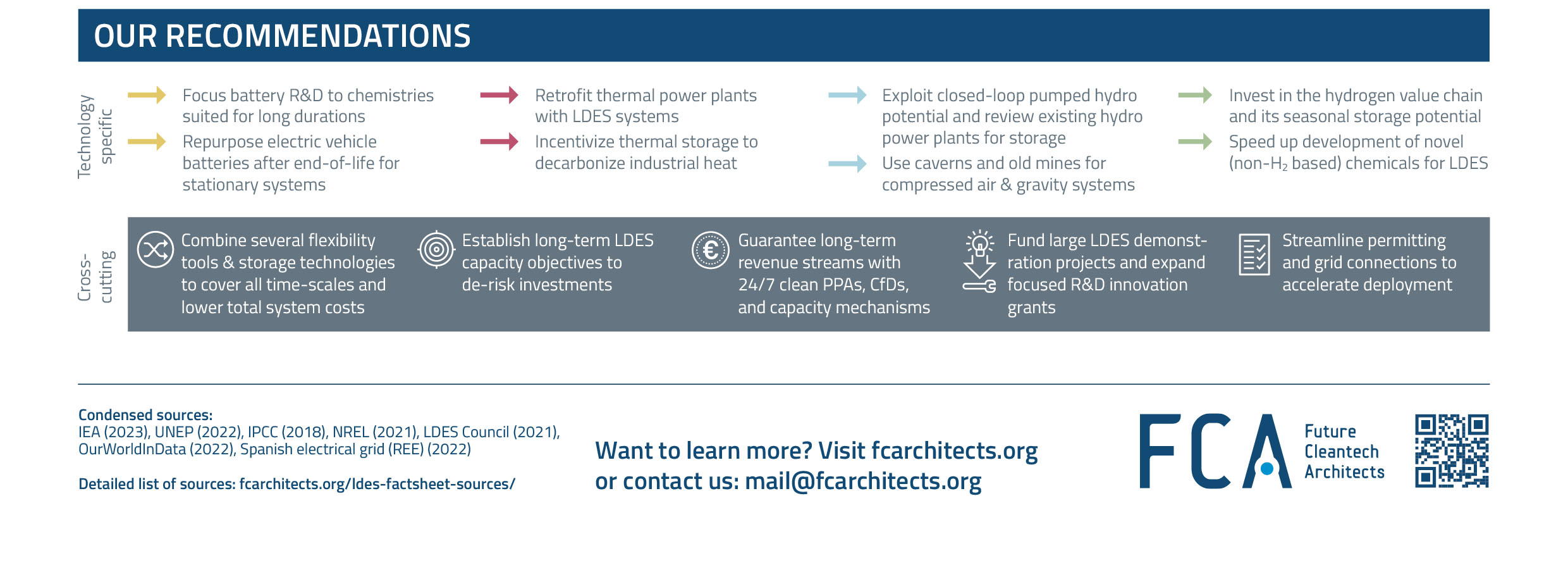
Show Sources
[1] Electricity generation emissions
Total global GHG emissions, around 55 Gt CO2eq: Our World in Data, “Greenhouse gas emissions” and UN environment programme, Emissions Gap Report 2022 (page 6, table 2.1).
Share of global GHG emissions from power sector, around 14 Gt CO2eq, or 26%: International Energy Agency, “CO2 emissions in 2022”, and Bill Gates, “How to avoid a climate disaster”
Distribution of CO2eq emissions from coal-fired power plants (around 10 Gt), gas-fired power plants (around 3 Gt) and other sources of power generation: This was computed combining power generation data from Our World in Data, “Electricity production by source” and emission-intensity data from the 5th IPCC report, Annex III, “Technology-specific Cost and Performance Parameters”. Value for coal validated in IEA, “Coal-Fired Electricity”.
[2] Electrical power system growing and transforming
Data on historical electricity production by source: Our World in Data, “Electricity production by source”
Data on predicted future electricity production by source: IEA, “Net zero by 2050” (net zero scenario, page 115)
[3] Solar and wind fluctuations and the need for flexibility
Graph generated using data from the Spanish electrical grid for the year 2022, when wind and solar reached 37% of total generation, and clean sources overall (including hydropower and nuclear) reached 63%. The “Projected clean sources” area was computed by adding extra wind and solar generation on top of current clean generation, to substitute all non-clean electricity, such that average clean generation equals average demand. The “Shortage” area represents the difference between demand and generation at specific times, and can be avoided with flexibility tools, such as long duration energy storage (LDES), in which generation surplus is stored and used to fill in the gaps. The electricity demand curve corresponds to unmodified data.
[4] Flexibility tools
Categories and applications of different flexibility tools: LDES Council, “Net-zero power” (Exhibit 6, page 6)
[5-6] LDES families and technologies characteristics
Own elaboration of infographic and technology tables, based on interviews with LDES technology developers and researchers.
Clearly defining LDES is not a straightforward task, as there is yet no absolute consensus. The definition we provide, “LDES includes any storage technology that can supply energy continuously, at rated power, for at least 10 hours in a row”, is based on recommendations from the NREL report, “The Challenge of defining Long-Duration Energy Storage”.
[7] Recommendations
Own elaboration, based on interviews with LDES innovators and on the results of a series of workshops on LDES market design co-hosted with Breakthrough Energy and EASE.
Long Duration Energy Storage (LDES) for Power Systems: A diverse field of technologies eager for deployment
To decarbonize electricity production, large amounts of wind and solar energy will be required. However, energy generated from these sources fluctuates, and does not generally align with load patterns. Scaling up a portfolio of Long Duration Energy Storage (LDES) technologies is urgently needed to decarbonize grids and provide energy security. The wide-ranging array of LDES technologies ensures a diversified supply chain.
The graph is a collaborative effort between Future Cleantech Architects and the LDES Council, and shows a non-exhaustive list of LDES technologies grouped according to their approximate discharge duration and deployment readiness. Please note, this image focuses on LDES technologies that can be used to supply electricity.
To learn more about the different LDES technologies for the power system, check out our complete blogpost.
Deep dives
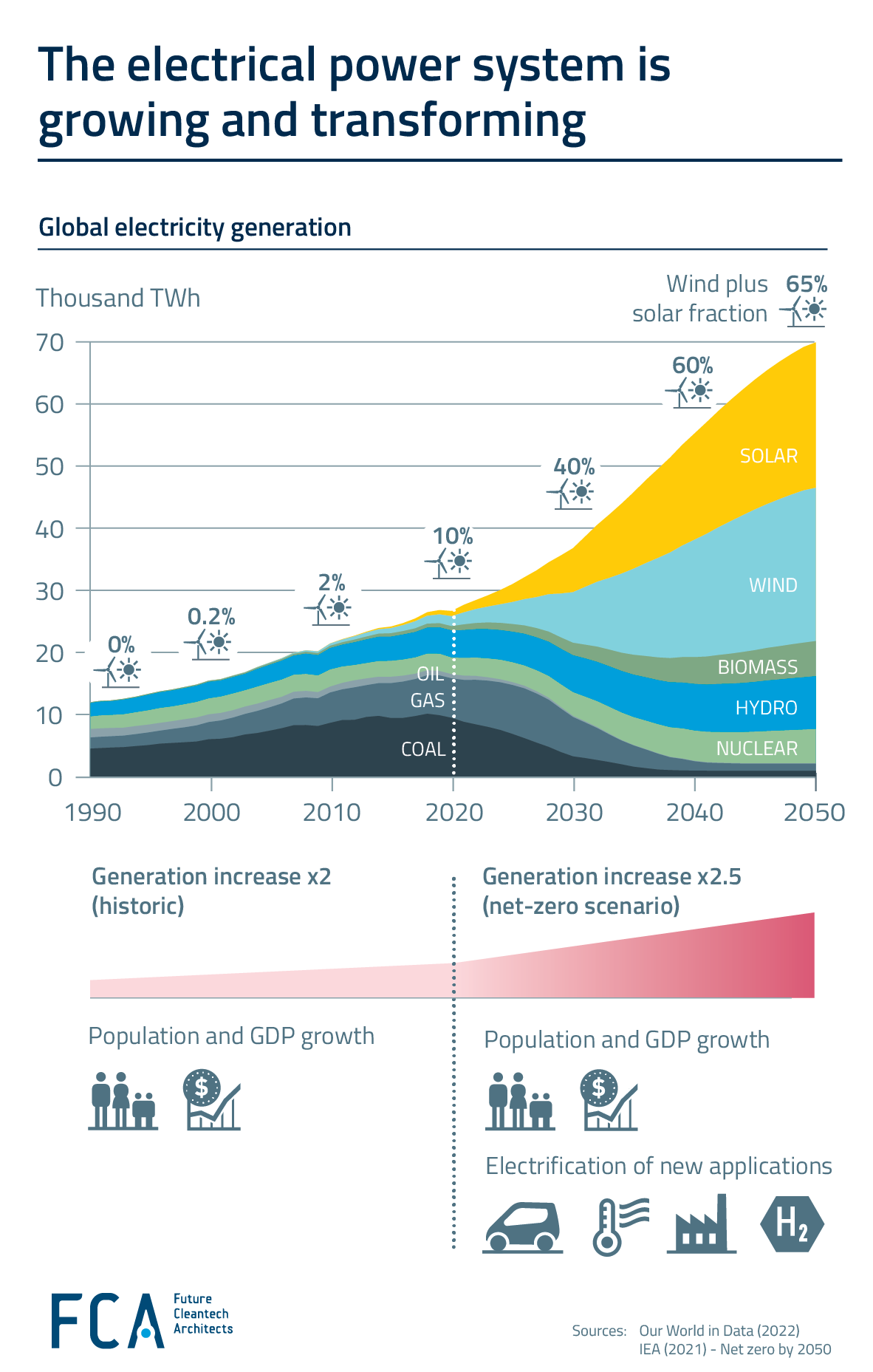
Why do we need long duration energy storage?
Did you know that global electricity generation currently accounts for over 25% of global greenhouse gas emissions? Additionally, the demand for global electricity generation has more than doubled in the last 30 years and is expected to double again by 2050 to meet continued population and GDP growth, as well as to cover the electrification of new sectors previously supplied with fossil fuels (such as heating, transport, and industrial processes).
The challenge ahead is huge and long duration energy storage (LDES), together with other energy flexibility tools, will be necessary to ensure security of supply and avoid massive waste of clean energy due to supply and demand fluctuations along daily, weekly, and seasonal time frames.
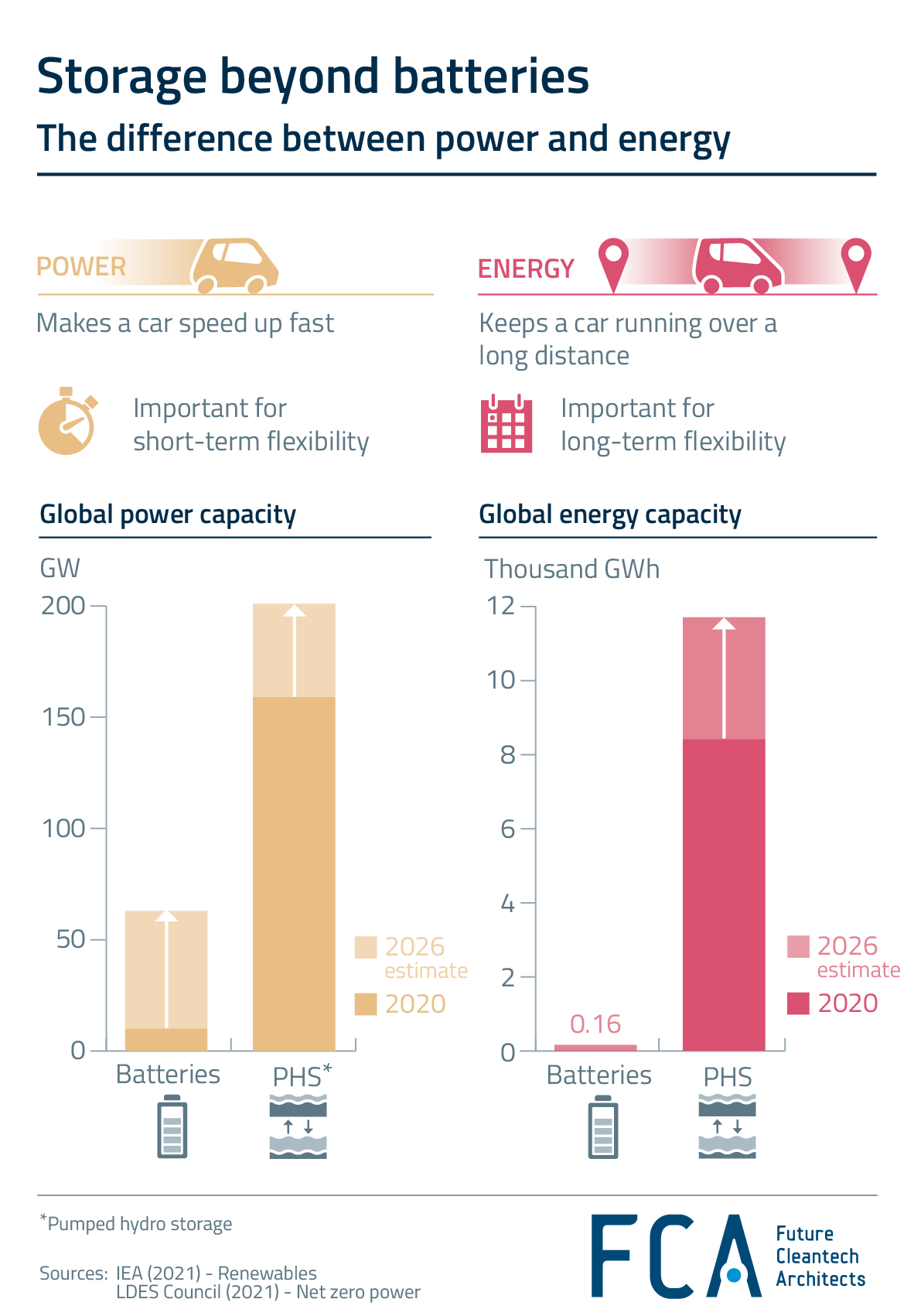
Storage beyond batteries: the difference between power and energy
Over the last two decades, Li-ion battery technology has risen in popularity, becoming a common choice for grid-scale energy storage facilities. However, when thinking about energy storage it is important to consider and distinguish between both power and energy.
Power, by definition, is the speed at which energy is delivered (e.g. how fast a car can go, thanks to its engine). Energy is obtained by delivering power over a certain period of time (e.g. how far the car can get, thanks to its tank).
Most conventional batteries are great at delivering power, which is useful for rapid, short-term fluctuations in the electrical grid. However, they are not able to economically deliver large quantities of energy, which is necessary to tackle seasonal fluctuations.
Other long duration energy storage (LDES) technologies, such as pumped hydro, thermal energy storage, and power-to-gas, are much better at storing large amounts of energy. Hence, they will be needed in applications that require electricity over long periods of time, ranging from 10 hours to seasonal. Pumped hydro, in particular, is the most mature and widespread grid-scale storage technology and will continue to dominate global energy capacity in the near future.
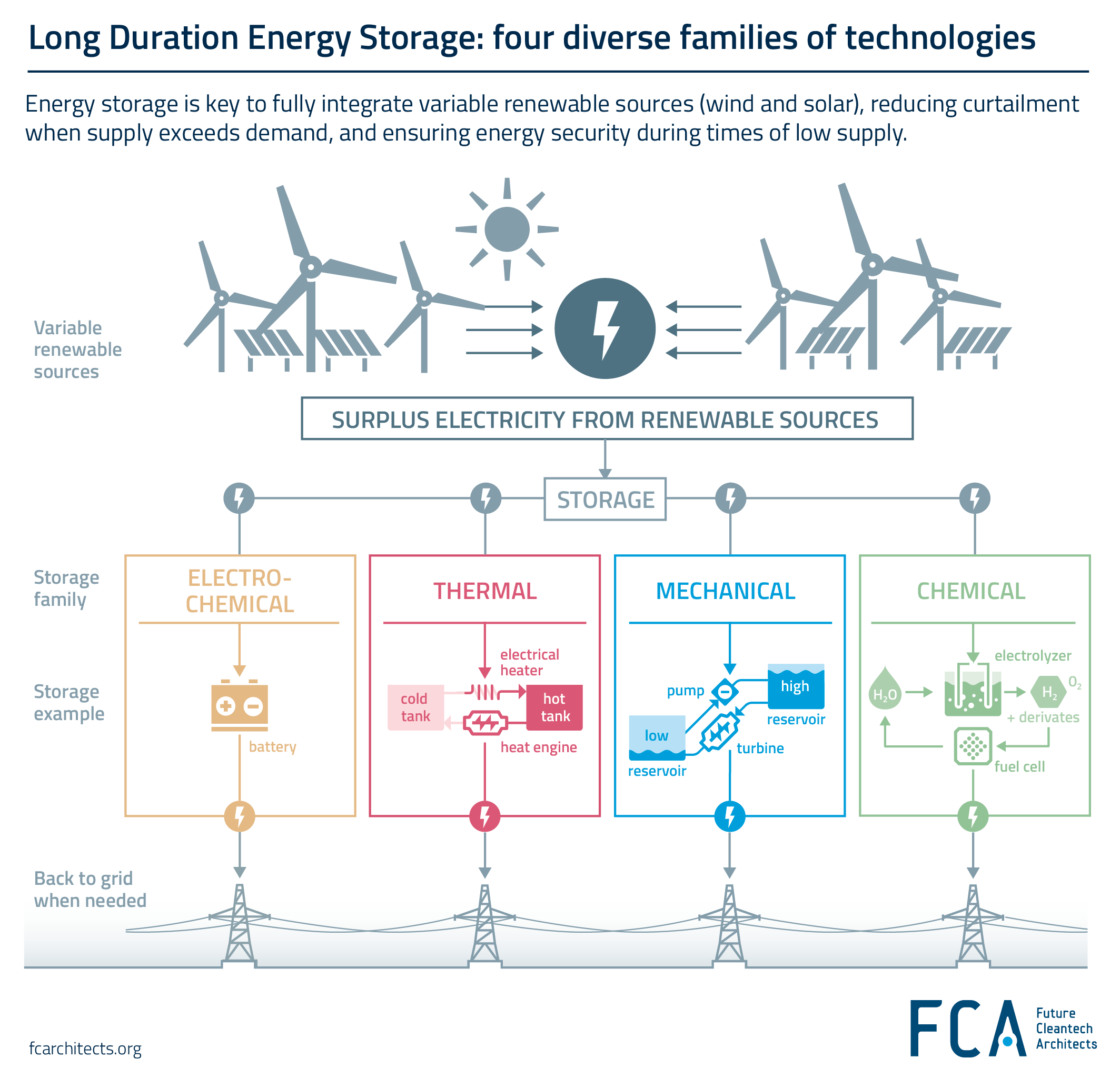
Different Long Duration Energy Storage technologies are needed to ensure grid flexibility and stability
Long Duration Energy Storage (LDES), as an essential piece of the flexibility toolbox, is needed to balance electricity supply and demand. It operates by storing surplus renewable production when supply exceeds demand and releasing it back to the grid when needed. This reduces renewable curtailment and ensures energy security during times of low supply. Four main families of LDES exist, with several technologies within each family:
🔶Mechanical LDES, which typically stores energy in the form of a gravitational or pressure potential, such as pumped hydroelectric storage and compressed air.
🔶Thermal LDES, which stores excess energy as high-temperature heat or cryogenic cold and releases it as needed to generate electricity. Examples include molten salt storage and liquid air.
🔶Chemical LDES, which employs reversible chemical reactions to store and release energy. Some examples are green hydrogen, hydrogen derivatives (such as ammonia and methane), and solid chemicals such as sulfur and iron powder.
🔶Electrochemical LDES, more commonly known as battery storage. Examples include lithium-ion batteries (suitable for shorter durations), flow batteries, and novel chemistries such as sodium and zinc.
As different LDES technologies are more suited to different applications, deploying a range of technologies will be necessary to ensure grid stability and security of supply over different time frames as the share of renewables increases.
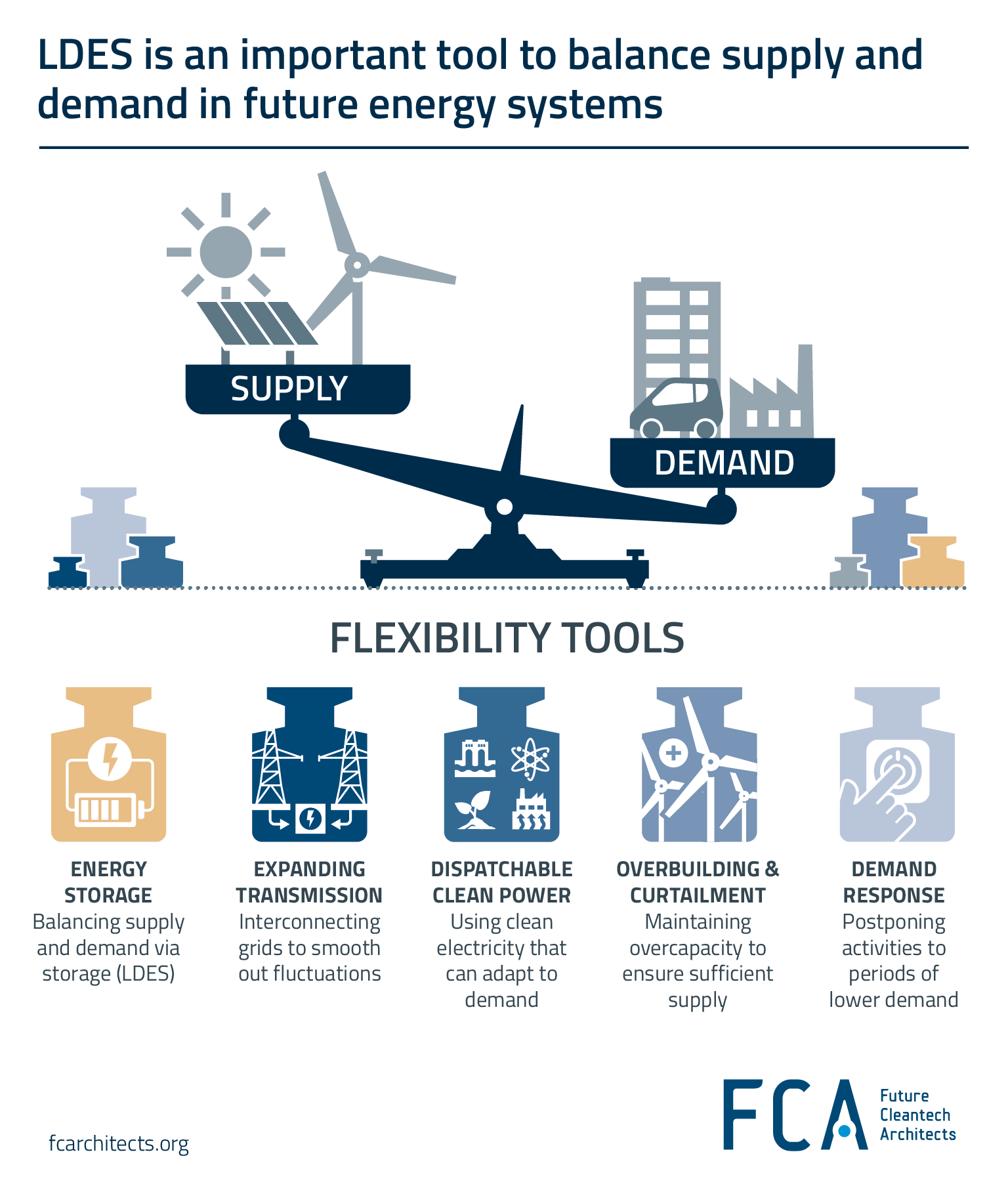
Long duration energy storage is a crucial flexibility tool for the electrical power system
Flexibility is needed at different times to smooth out supply and demand curves that change throughout the day and during different seasons. While gas peaker plants are a common tool used to fill in supply gaps in many countries, many low-carbon alternatives exist, such as grid interconnection, clean dispatchable sources, renewable overcapacity, demand response, and long duration energy storage (LDES).
LDES is one of the most crucial pieces of the energy flexibility puzzle, specially for countries reaching high shares of wind and solar power. By incorporating LDES into the grid, utilities can better manage the balance between supply and demand, improve energy security and reduce curtailment (waste of excess production) of renewable sources.
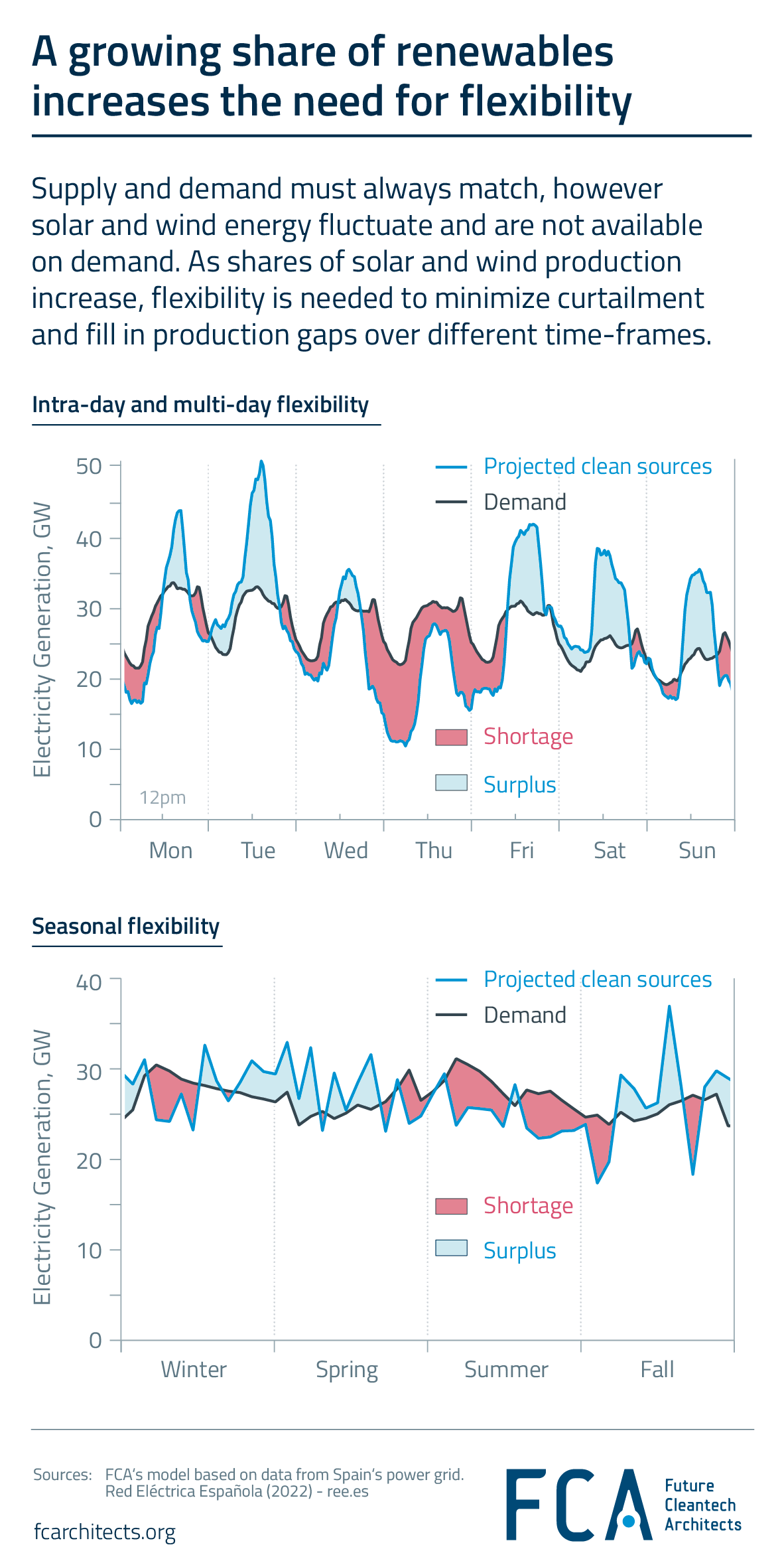
The need for flexibility tools such as long duration energy storage increases as the share of non-dispatchable renewables grows
Solar and wind energy are the cheapest and fastest growing sources of electricity in most world regions. Globally, about a dozen of countries already meet over 25% of their electricity needs with just solar and wind. In some cases, the share is even larger – Denmark is already at over 50% and Spain and Uruguay close to 40%.
Solar and wind energy fluctuate and are not available on demand. However, supply and demand must match at all times. This means that flexible sources are needed to balance the fluctuations.
Currently, flexibility is mostly provided by either burning fossil fuels (i.e. gas peaker plants) or hydropower stations. However, fossil fuels need to be phased out and hydropower is not universally available. In many cases, new low-carbon flexibility tools, such as long duration energy storage (LDES), will be required to minimize curtailment and fill in production gaps within daily, weekly, and seasonal timeframes.
LDES is one of the most crucial pieces of the energy flexibility puzzle, specially for countries reaching high shares of wind and solar power. By incorporating LDES into the grid, utilities can better manage the balance between supply and demand, improve energy security and reduce curtailment (waste of excess production) of renewable sources.
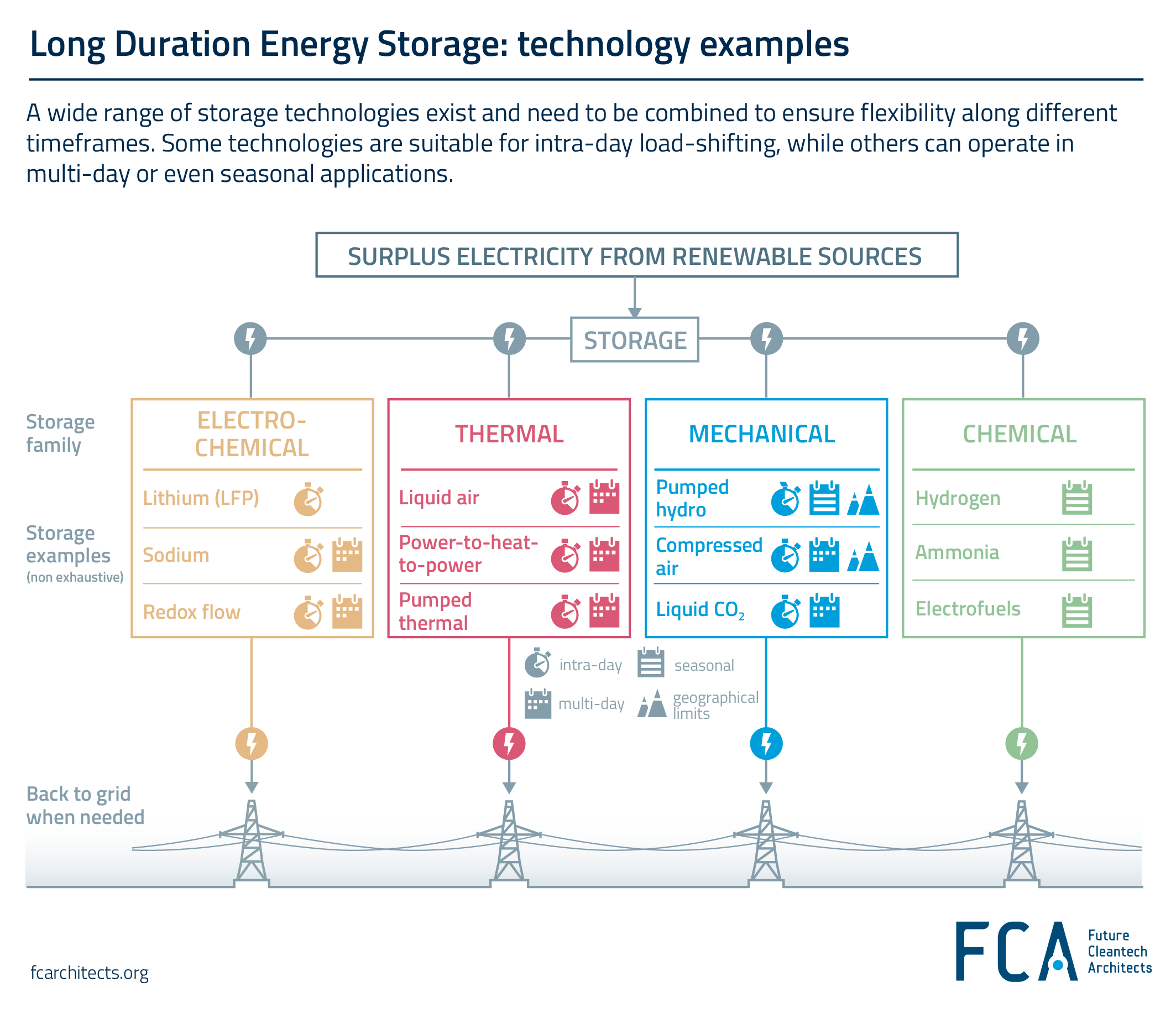
Energy flexibility along different timeframes will require a wide range of Long Duration Energy Storage technologies
Long Duration Energy Storage (LDES) constitutes any storage technology that can supply electricity continuously for at least several consecutive hours (typically, >8 hours). Four families of LDES exist with different technologies in each of the families: electrochemical, thermal, mechanical, and chemical.
With some exceptions, electrochemical technologies tend to have the shortest durations, which is best for power quality and intra-day applications. Chemical storage is most suited for seasonal applications, while thermal and mechanical technologies fit in the middle.
While lithium-ion battery installations are growing quickly, that won’t be enough. A range of different LDES technologies will be needed to cover storage needs over intra-day, multi-day, and seasonal timeframes. When done properly, this will enable higher shares of solar and wind energy in the electric grid, improve energy security, and lower overall system costs.
